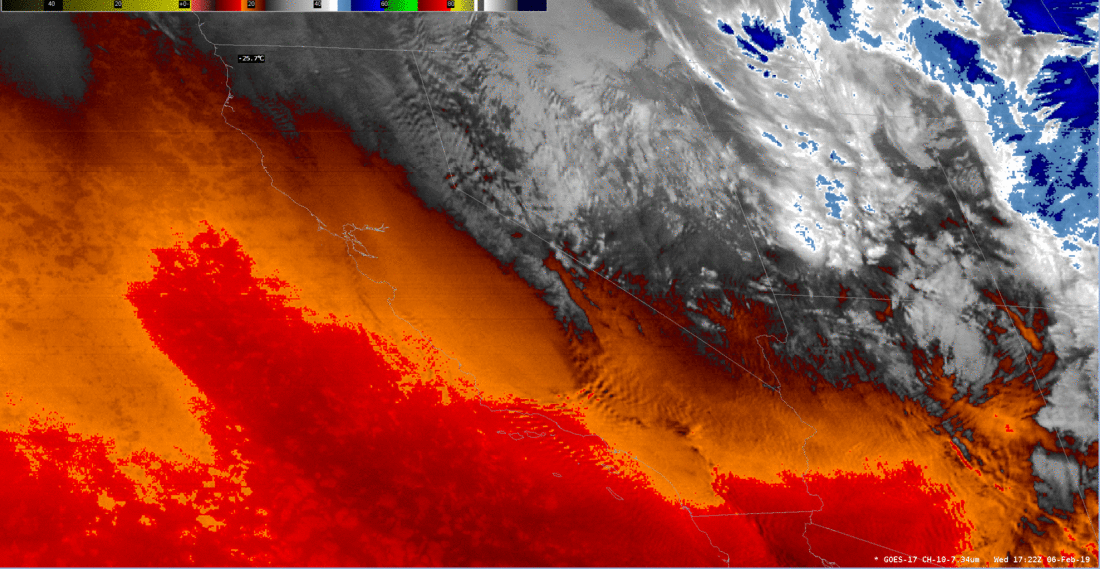Satellite Operations Updates - Total Operational Weather Readiness - Satellites (TOWR-S)
GOES-R Satellite Series Mode 6 Testing and GOES-17 Imagery Anomalies
February 7, 2019
![]() 2:30 minute read
2:30 minute read
In the coming weeks, NESDIS will perform two tests of the GOES Advanced Baseline Imager (ABI) operating in Mode 6. Mode 6 is an enhancement to the current ABI Flex Mode (Mode 3), in which a full disk image is taken every ten minutes instead of every fifteen minutes.
On Feb. 8, the first ABI Mode 6 test will occur for GOES-16 from 15z to 17z. On Feb. 19, the second ABI Mode 6 test will occur for both GOES-16 and GOES-17, beginning at 15z and concluding on Feb. 22 at 15z. This will be a 72 hour test.
These tests are important to NWS because ABI Mode 6 will likely become the primary operational mode for both GOES-16 and GOES-17 on or after March 13, 2019. Additionally, GOES-R engineers determine operating ABI in the new Mode 6 timeline will help alleviate the impact of a newly identified anomaly called the Periodic Infrared Calibration Anomaly (PICA). PICA is currently impacting the 7.4 um Low-Level Water Vapor Channel and the 9.6 um Ozone Channel on the GOES-17 ABI.
For more details on ABI Mode 6 Testing, refer to the previous TOWR-S announcement, GOES-17 ABI Mode 6 Testing [Jan. 25, 2019] here.
PICA is caused by the existing Loop Heat Pipe (LHP) issue. When PICA occurs, a loop of CONUS imagery shows small fluctuations in the brightness temperatures of the image. Specifically, three consecutive images will show a “hot” “hot” “cold” pattern. PICA can make it challenging for forecasters trying to detect changes in brightness temperature.
According to GOES-R product quality engineer Dave Pogorzala, the LHP issue makes it more difficult for the ABI to maintain a consistent temperature, causing the PICA anomaly to occur. As the ABI operates, it takes time between scans of the Earth to calibrate itself. This can be done by looking out into space, looking at a star, or by looking at a blackbody. To mitigate PICA, GOES-R satellite engineers have created a new calibration scan strategy for the GOES-17 ABI, and that strategy has been programmed into the GOES-17 Mode 6.
Below are AWIPS screenshots of three consecutive CONUS images from the GOES-17 7.4 um Low-Level Water Vapor channel, taken on Feb. 6, 2019, at 17:22, 17:27 and 17:32 over the western United States. Note the brightness temperatures for the first two images are slightly warmer than the third image.

PICA will be significantly mitigated once GOES-17 switches over to Mode 6 permanently on or after March 13, 2019.
For questions or concerns, contact the TOWR-S team by joining the ‘towr-s’ group via the NWS Chat.
- 2023 Satellite Operation Communications
- 2022 Satellite Operation Communications
- 2021 Satellite Operation Communications
- 2020 Satellite Operation Communications
- Loop Heat Pipe Anomaly Impacts on GOES-17 ABI Bands 11 & 15 [October 15, 2020]
- Loop Heat Pipe Anomaly Impacts on GOES-17 ABI Band 9 [October 13, 2020]
- Loop Heat Pipe Anomaly Impacts on GOES-17 ABI Bands 8, 10, 12 & 16 [October 9, 2020]
- GOES-17 ABI Loop Heat Pipe Anomaly Fall Season Preview [October 7, 2020]
- GOES-17 Loop Heat Pipe Anomaly Summer Season Concludes [September 1, 2020]
- Loop Heat Pipe Anomaly Impacts on GOES ABI Bands 13 & 14 [August 26, 2020]
- Loop Heat Pipe Anomaly Impacts on GOES ABI Band 15 [August 14, 2020]
- GOES-17 Mode 3 Cooling Timeline Operations [August 10, 2020]
- Loop Heat Pipe Anomaly Impacts on GOES ABI Band 11 [August 10, 2020]
- GOES-17 Loop Heat Pipe Anomaly Impacts Update [August 4, 2020]
- Loop Heat Pipe Anomaly Impacts on GOES-17 ABI Band 8 [July 30, 2020]
- Loop Heat Pipe Anomaly Impacts on GOES-17 ABI Band 10 [July 29, 2020]
- Loop Heat Pipe Anomaly Impacts on GOES-17 ABI Bands 12 & 16 [July 24, 2020]
- GOES-17 Cooling System Impacts Update [July 22, 2020]
- GOES-17 Mode 3 Cooling Timeline Operations [April 3, 2020]
- GOES-17 Cooling System Impacts Update [April 3, 2020]
- Upcoming Deactivation of GOES-15 Operations and Products [February 27, 2020]
- GOES-W Scan Strategy Testing [February 18, 2020]
- GOES-17 Cooling System Impacts Update [February 5, 2020]
- 2019 Satellite Operation Communications
- GOES-W Scan Strategy Testing [December 9, 2019]
- Mode 6: GOES-E/W ABI Operational Flex Mode Transition to 10 Minute Cycle [March 29, 2019]
- GOES-W Yaw Flip Data Outage [March 27, 2019]
- GOES-R Satellite Series: Upcoming ABI Mode 6 Testing [February 19, 2019]
- GOES-R Satellite Series Mode 6 Testing and GOES-17 Imagery Anomalies [February 7, 2019]
- GOES-17 ABI Mode 6 Testing [January 25, 2019]
- GOES-17 Cooling System Impacts Update [January 17, 2019]
- 2017 Satellite Operation Communications



